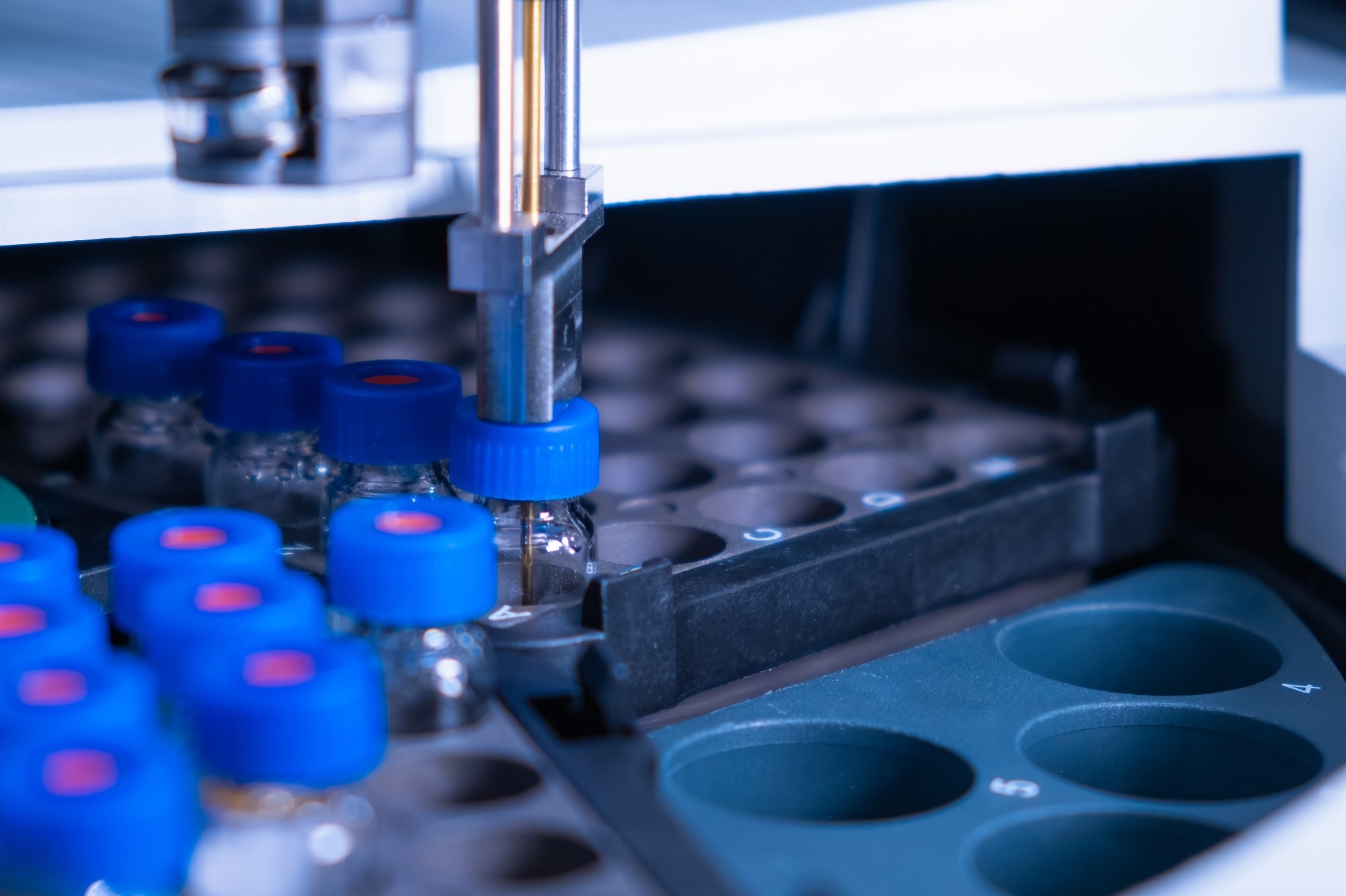Lipidomics, the study of lipid molecules within biological systems, emerged in the 1990s and early 2000s.1
Since then, the study of lipids' composition, structure, and function has gained momentum as its crucial role in understanding cellular lipid profiles, which are fundamental for various biological functions, has become vital.
 Image Credit: Vladimka production/Shutterstock.com
Image Credit: Vladimka production/Shutterstock.com
Introduction
Leveraging numerous analytical techniques, including mass spectrometry and chromatography alongside lipidomics, makes it possible to characterize lipids within cells and tissues.
This is crucial to revealing the characteristic alterations in lipid metabolism that occur in various diseases, including cancer, metabolic syndromes, and cardiovascular diseases.2
With lipidomics, scientists can identify potential disease biomarkers, helping to develop strategies for early disease detection and therapeutic targeting. Lipidomics has become pivotal in forging breakthroughs in advancing our understanding of various diseases and developing novel personalized medicine strategies.
Lipidomics: Foundations and Advances
Lipidomics involves the systematic study of the structure, function, and dynamics of lipid molecules within a biological system.1
The discipline utilizes advanced analytical techniques, such as mass spectrometry and chromatography, to obtain vital information on lipids' composition, distribution, and interactions.
This reveals their roles in biological processes, such as membrane formation and signaling. Through lipidomics, researchers have been able to identify disease biomarkers and therapeutic targets for many diseases.
While the techniques leveraged in lipidomics offer the advantages of high sensitivity and specificity, they also face challenges surrounding data interpretation and quantification and challenges involving sample preparation.
However, despite these challenges, lipidomics continues to be vitally important for medical sciences, and advances in the field have helped to improve its reliability for clinical research.
Techniques in Next-Generation Lipidomics
Next-generation lipidomics relies on cutting-edge methodologies, such as high-resolution mass spectrometry, shotgun lipidomics, and lipid imaging, to provide enhanced lipidomic analyses.
In next-generation lipidomics, high-resolution mass spectrometry is utilized to precisely identify and quantify lipids. This technique offers enhanced accuracy compared to conventional techniques.
Shotgun lipidomics streamlines analyses by analyzing lipid extracts without the need for prior separation. This technique provides rapid profiling of lipid species.
Other techniques, such as MALDI-MSI (matrix-assisted laser desorption/ionization mass spectrometry imaging) and SIMS (secondary ion mass spectrometry), allow for the spatial mapping of lipid distributions, offering important insights into lipid localization and lipid dynamics.3
When leveraged in lipidomics, these cutting-edge techniques offer high sensitivity, throughput, and the comprehensive characterization of lipid profiles, which facilitates the identification of disease biomarkers and therapeutic targets.
However, these methods are not without their challenges, including data interpretation complexities, limited coverage of lipid classes, and the demand for specialized equipment and trained staff. Despite these challenges, ongoing advancements in lipidomic techniques help further improve such techniques' reliability in lipidomics research.
Role of Lipidomics in Disease Biomarker Discovery
Lipidomic profiles have been developed for a number of diseases, including various cancers and cardiovascular diseases, diabetes, and neurodegenerative diseases.2
For example, specific lipids such as ceramics and oxidized phospholipids have been linked with an increased risk of disease in cardiovascular diseases.4
In diabetes, elevated levels of triglycerides and reduced levels of some phospholipids have been associated with disease onset and progression. Certain lipidomic signatures have been unveiled that are characteristic of neurodegenerative diseases, such as Alzheimer’s disease.
Lipidomics has helped identify potential therapeutic targets, helping researchers develop novel therapeutic interventions that can potentially improve patient outcomes in several diseases.
Challenges in Lipidomic Biomarker Validation
Several challenges face the validation of lipid-based biomarkers in clinical research, such as reproducibility issues, the complexity of lipid metabolism, and the need for large-scale studies.
Collaborative efforts have been made to enhance data sharing, method standardization, and validation in lipidomic studies to overcome the reproducibility issue. Multi-center collaborative efforts are helping to improve the reliability and generalizability of findings from lipidomic studies.
In addition, establishing quality control measures and detailed reference materials further enhances the reproducibility of the studies. By leveraging these strategies, the field of lipidomics is becoming more reliable and is more valuable in advancing novel therapeutic techniques and improving patient outcomes.
Future Directions in Lipidomic Research
Emerging trends in lipidomics include integrating lipidomic data alongside genomic and proteomic data to fully understand cellular metabolism. This interdisciplinary approach reveals the molecular interactions and pathways underpinning various diseases.
Additionally, artificial intelligence (AI) and machine learning techniques have the potential to revolutionize lipidomic analysis and interpretation,5 enabling the identification of meaningful patterns from large datasets, which is crucial for biomarker discovery, the development of new therapeutic agents, and the development of personalized medicine.
Conclusion
Lipidomics is vital for understanding the cellular lipid profiles and metabolic pathways that underlie various diseases. By utilizing advanced analytical techniques, lipidomics has become useful in identifying potential disease biomarkers and therapeutic agents.
While the field faces some challenges, continued advancement is helping lipidomics improve its reliability in clinical research. To fully exploit the diagnostic power of lipid profiles, continued innovation and collaboration are needed.
References
- Han, X. and Gross, R.W. (2022) ‘The foundations and development of Lipidomics’, Journal of Lipid Research, 63(2), p. 100164. doi:10.1016/j.jlr.2021.100164.
- Zhao, Y.-Y., Cheng, X. and Lin, R.-C. (2014) ‘Lipidomics applications for discovering biomarkers of diseases in clinical chemistry’, International Review of Cell and Molecular Biology, pp. 1–26. doi:10.1016/b978-0-12-800177-6.00001-3.
- Baquer, G. et al. (2023) ‘RMSIfragment: Improving MALDI-MSI lipidomics through automated in-source fragment annotation’, Journal of Cheminformatics, 15(1). doi:10.1186/s13321-023-00756-2.
- Ashraf, M.Z., Kar, N.S. and Podrez, E.A. (2009) ‘Oxidized phospholipids: Biomarker for cardiovascular diseases’, The International Journal of Biochemistry & Cell Biology, 41(6), pp. 1241–1244. doi:10.1016/j.biocel.2008.11.002.
- Castañé, H. et al. (2021) ‘Coupling machine learning and lipidomics as a tool to investigate metabolic dysfunction-associated fatty liver disease. A general overview’, Biomolecules, 11(3), p. 473. doi:10.3390/biom11030473.
Further Reading
Last Updated: May 30, 2024